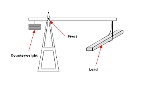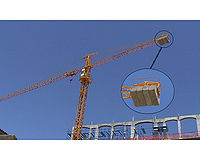
Counterweight
Encyclopedia

Uses
A counterweight is often used in traction liftsElevator
An elevator is a type of vertical transport equipment that efficiently moves people or goods between floors of a building, vessel or other structures...
(elevators), crane
Crane (machine)
A crane is a type of machine, generally equipped with a hoist, wire ropes or chains, and sheaves, that can be used both to lift and lower materials and to move them horizontally. It uses one or more simple machines to create mechanical advantage and thus move loads beyond the normal capability of...
s and funfair
Funfair
A funfair or simply "fair" is a small to medium sized travelling show primarily composed of stalls and other amusements. Larger fairs such as the permanent fairs of cities and seaside resorts might be called a fairground, although technically this should refer to the land where a fair is...
rides. In these applications, the expected load multiplied by the distance that load will be spaced from the central support (called the "tipping point") must be equal to the counterweight's mass times its distance from the tipping point in order to prevent over-balancing either side. This distance times mass is called the load moment
Moment (physics)
In physics, the term moment can refer to many different concepts:*Moment of force is the tendency of a force to twist or rotate an object; see the article torque for details. This is an important, basic concept in engineering and physics. A moment is valued mathematically as the product of the...
.
Counterweights in action

Trebuchet
A trebuchet is a siege engine that was employed in the Middle Ages. It is sometimes called a "counterweight trebuchet" or "counterpoise trebuchet" in order to distinguish it from an earlier weapon that has come to be called the "traction trebuchet", the original version with pulling men instead of...
: There are five major components of a trebuchet: beam, counterweight, frame, guide chute, and sling. After the counterweight drops from a platform on the frame, gravity pulls the counterweight and pivots the beam. Without the counterweight, the beam could not complete the arc that allows the sling to accurately release the projectile.
Crankshaft
Crankshaft
The crankshaft, sometimes casually abbreviated to crank, is the part of an engine which translates reciprocating linear piston motion into rotation...
: A counterweight is also used in many rotating systems to reduce vibrations due to imbalances in the rotating assembly. A typical example is counterweights on crankshaft
Crankshaft
The crankshaft, sometimes casually abbreviated to crank, is the part of an engine which translates reciprocating linear piston motion into rotation...
s in piston engines.
Desk lamp: Some balanced arm lamps
Balanced arm lamps
A balanced-arm lamp is a lamp with an adjustable folding arm which is constructed so that the force due to gravity is always counteracted by springs, regardless of the position of the arms of the lamp...
work with a counterweight to keep the arm and lamp in the desired position.
Elevator
Elevator
An elevator is a type of vertical transport equipment that efficiently moves people or goods between floors of a building, vessel or other structures...
: In traction (non-hydraulic) elevators, a heavy counterweight counterbalances the load of the elevator car, so the motor
Electric motor
An electric motor converts electrical energy into mechanical energy.Most electric motors operate through the interaction of magnetic fields and current-carrying conductors to generate force...
lifts much less of the car's weight (specifically, the counterweight is the weight of the car plus 40-50% of its rated capacity). The counterweight also increases the ascending acceleration force and decreases the descending acceleration force to reduce the amount of power needed by the motor. The elevator car and the counterweights both have guide rollers attached to them to prevent irregular movement and provide a smoother ride for the passengers.
Space elevator
Space elevator
A space elevator, also known as a geostationary orbital tether or a beanstalk, is a proposed non-rocket spacelaunch structure...
: A space elevator
Space elevator
A space elevator, also known as a geostationary orbital tether or a beanstalk, is a proposed non-rocket spacelaunch structure...
is a proposed structure designed to transport material from a celestial body
Astronomical object
Astronomical objects or celestial objects are naturally occurring physical entities, associations or structures that current science has demonstrated to exist in the observable universe. The term astronomical object is sometimes used interchangeably with astronomical body...
's surface
Surface
In mathematics, specifically in topology, a surface is a two-dimensional topological manifold. The most familiar examples are those that arise as the boundaries of solid objects in ordinary three-dimensional Euclidean space R3 — for example, the surface of a ball...
into space. Many variants have been proposed, but the concept most often refers to an elevator that reaches from the surface of the Earth
Earth
Earth is the third planet from the Sun, and the densest and fifth-largest of the eight planets in the Solar System. It is also the largest of the Solar System's four terrestrial planets...
to geostationary
Geostationary orbit
A geostationary orbit is a geosynchronous orbit directly above the Earth's equator , with a period equal to the Earth's rotational period and an orbital eccentricity of approximately zero. An object in a geostationary orbit appears motionless, at a fixed position in the sky, to ground observers...
outer space
Outer space
Outer space is the void that exists between celestial bodies, including the Earth. It is not completely empty, but consists of a hard vacuum containing a low density of particles: predominantly a plasma of hydrogen and helium, as well as electromagnetic radiation, magnetic fields, and neutrinos....
, with a counterweight attached at its outer end.
By attaching a counterweight at the end, inertia
Inertia
Inertia is the resistance of any physical object to a change in its state of motion or rest, or the tendency of an object to resist any change in its motion. It is proportional to an object's mass. The principle of inertia is one of the fundamental principles of classical physics which are used to...
ensures that the cable remains stretched taut, countering the gravitational pull on the lower sections and thereby allowing the elevator to remain in geostationary orbit.
The counterweight itself could assume one of several forms:
- a heavy, captured asteroidAsteroidAsteroids are a class of small Solar System bodies in orbit around the Sun. They have also been called planetoids, especially the larger ones...
(as shown in the diagram); - a space dock, space stationSpace stationA space station is a spacecraft capable of supporting a crew which is designed to remain in space for an extended period of time, and to which other spacecraft can dock. A space station is distinguished from other spacecraft used for human spaceflight by its lack of major propulsion or landing...
or spaceportSpaceportA spaceport or cosmodrome is a site for launching spacecraft, by analogy with seaport for ships or airport for aircraft. The word spaceport, and even more so cosmodrome, has traditionally been used for sites capable of launching spacecraft into orbit around Earth or on interplanetary trajectories...
positioned past geostationary orbit; or - an extension of the cable itself far beyond geostationary orbit.

Metronome
A metronome is any device that produces regular, metrical ticks — settable in beats per minute. These ticks represent a fixed, regular aural pulse; some metronomes also include synchronized visual motion...
: A wind-up mechanical metronome has an adjustable weight and spring mechanism that allows the speed to be adjusted by placement of the weight on the spindle. The tempo speed is decreased by moving the weight to a higher spindle marking or increased by moving it to a lower marking.
Crane (machine)
Crane (machine)
A crane is a type of machine, generally equipped with a hoist, wire ropes or chains, and sheaves, that can be used both to lift and lower materials and to move them horizontally. It uses one or more simple machines to create mechanical advantage and thus move loads beyond the normal capability of...
: The tower crane (see picture) is a modern form of balance crane that is fixed to the ground. A horizontal boom is balanced asymmetrically across the top of the tower. The long arm carries the lifting gear. The short arm is called the machinery arm; this holds the motors and electronics to operate the crane, as well as the concrete counterweights.
- Vertical lift bridge
- DrawbridgeDrawbridgeA drawbridge is a type of movable bridge typically associated with the entrance of a castle surrounded by a moat. The term is often used to describe all different types of movable bridges, like bascule bridges and lift bridges.-Castle drawbridges:...
- Bascule bridgeBascule bridgeA bascule bridge is a moveable bridge with a counterweight that continuously balances the span, or "leaf," throughout the entire upward swing in providing clearance for boat traffic....

